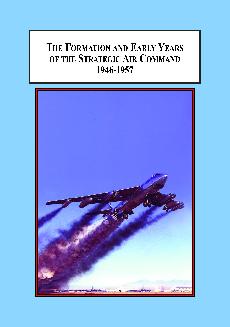Formation and Early Years of the Strategic Air Command, 1946-1957: Why the Sac Was Formed
We are currently unable to ship to the EU countries at this time. We apologize for this inconvenience.

| Author: | Meilinger, Phillip S. | |
| Year: | 2013 | |
| Pages: | 400 | |
| ISBN: | 0-7734-4465-3 978-0-7734-4465-2 | |
| Price: | $239.95 + shipping | |
| (Click the PayPal button to buy) | ||
The Strategic Air Command (SAC) was formed to deter war against the emerging Soviet threat –and to fight and win a war if deterrence failed.
This fascinating history of SAC will weave together six themes shaping the command during its first decade of existence: mission, message, education, technology, intelligence gathering and analysis, and leadership. All of these were crucial but the last is perhaps primus inter pares. General Curtis E. LeMay was the commander of SAC from 1948 to 1957. His leadership and drive were fundamental to the successful evolution of the command.
This fascinating history of SAC will weave together six themes shaping the command during its first decade of existence: mission, message, education, technology, intelligence gathering and analysis, and leadership. All of these were crucial but the last is perhaps primus inter pares. General Curtis E. LeMay was the commander of SAC from 1948 to 1957. His leadership and drive were fundamental to the successful evolution of the command.
Reviews
A thorough and well-documented analysis of the formation and early years of SAC, that not only informs us on that heroic period in Air Force history, but also provides an understanding of the fundamental and often uncomfortable changes still facing the service in this post—Cold War era.”
Gen John A. Shaud, PhD, USAF, Retired
Director, Air Force Research Institute
“This work sheds light on a very interesting period in USAF and American history where nuclear weapons become an integral part of the national policy (deterrence), force structure, organization and strategy.”
Colonel Dr John Andreas Olsen,
Deputy Commander of NATO HQ Sarajevo
“Absolutely the best work that I have examined concerning coverage of the Cold War birth of the USAF and all of the growing pains that went along with it.”
Dr Dik Daso,
Curator of Modern Military Aircraft
Smithsonian Institution, National Air and Space Museum
Gen John A. Shaud, PhD, USAF, Retired
Director, Air Force Research Institute
“This work sheds light on a very interesting period in USAF and American history where nuclear weapons become an integral part of the national policy (deterrence), force structure, organization and strategy.”
Colonel Dr John Andreas Olsen,
Deputy Commander of NATO HQ Sarajevo
“Absolutely the best work that I have examined concerning coverage of the Cold War birth of the USAF and all of the growing pains that went along with it.”
Dr Dik Daso,
Curator of Modern Military Aircraft
Smithsonian Institution, National Air and Space Museum
Table of Contents
About the Author
Foreword
Introduction
Abbreviations
1 The Intellectual and Organizational Imperatives for Bombing
The Influence of Billy Mitchell
The Air Corps Tactical School—the Early Years
The Air Corps Tactical School—the Golden Age
Bombing accuracy and Targeting
Summary
2 The Realities of War and Strategic Bombing
Organization for Combat
Planning the Air Campaign—AWPD-1
Problems and the Development of Operations Research
Air Intelligence and Targeting
Analyzing the Effects—the US Strategic Bombing Survey
Summary
3 Formation
The Bomb and Its Relevance
Planning the Atomic Air Force
Reorganization and Strategic Air Command
Initial problems
The Deployment Challenge
The Bikini Atomic Tests
Summary
4 Independence Mixed with Challenges
Roles and Missions
Planning for Atomic War
The Berlin Crisis and the Rebirth of SAC
Summary
5 Expansion and Adversity
Reforging the Weapon
The Revolt of the Admirals
Evaluating the Atomic Air Offensive
Budget battles
Intelligence and Joe 1
Summary
The Men and Machines That Built Strategic Air Command—Photo Montage
6 Nuclear Weapons, Custody, and the Korean War
The Outbreak of War
Custody of Atomic Weapons
Stalemate in Korea
Summary
7 Building the Bombers
The Challenge of Range
The Penetration problem
The Importance of Electronic Warfare and Countermeasures
Summary
8 Expansion, Intelligence, and Targeting in the Nuclear Age
Thoughts on Total War
The “New Look” and Tactical Nuclear Weapons
Intelligence and targeting
Summary
9 Retrospect and Epilogue
Appendix
Bibliography
Index
Foreword
Introduction
Abbreviations
1 The Intellectual and Organizational Imperatives for Bombing
The Influence of Billy Mitchell
The Air Corps Tactical School—the Early Years
The Air Corps Tactical School—the Golden Age
Bombing accuracy and Targeting
Summary
2 The Realities of War and Strategic Bombing
Organization for Combat
Planning the Air Campaign—AWPD-1
Problems and the Development of Operations Research
Air Intelligence and Targeting
Analyzing the Effects—the US Strategic Bombing Survey
Summary
3 Formation
The Bomb and Its Relevance
Planning the Atomic Air Force
Reorganization and Strategic Air Command
Initial problems
The Deployment Challenge
The Bikini Atomic Tests
Summary
4 Independence Mixed with Challenges
Roles and Missions
Planning for Atomic War
The Berlin Crisis and the Rebirth of SAC
Summary
5 Expansion and Adversity
Reforging the Weapon
The Revolt of the Admirals
Evaluating the Atomic Air Offensive
Budget battles
Intelligence and Joe 1
Summary
The Men and Machines That Built Strategic Air Command—Photo Montage
6 Nuclear Weapons, Custody, and the Korean War
The Outbreak of War
Custody of Atomic Weapons
Stalemate in Korea
Summary
7 Building the Bombers
The Challenge of Range
The Penetration problem
The Importance of Electronic Warfare and Countermeasures
Summary
8 Expansion, Intelligence, and Targeting in the Nuclear Age
Thoughts on Total War
The “New Look” and Tactical Nuclear Weapons
Intelligence and targeting
Summary
9 Retrospect and Epilogue
Appendix
Bibliography
Index
Other Military History Books
2001 - Story of Joshua D. Breyfogle, Private, 4th Ohio Infantry (10th Ohio Cavalry) and the Civil War
>> See all our Military History books